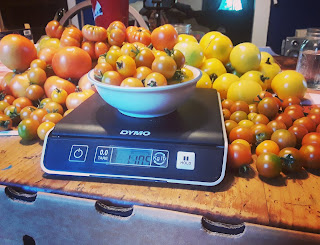Farmers' Market 101
I eventually received an invite from a small but well established market in New Berlin N.Y. I decided to venture outside of my comfort and commit to setting up a booth for the 2019 season. Knowing that I was going to be attempting to not only feed my own family but weekly customers well before the season started was a huge advantage. It provided me with the opportunity to carefully plan my garden layout and my product line.
With the benefit of hind sight I can now confidently pass along some advice that will prove invaluable to anyone considering this vocation. Lets start with the basics;
Soil Health: Healthy soil equals healthy plants. Remember to feed your soil well ahead of planting with organic matter such as composted kitchen scraps and animal manures. We have had a great deal of success with rabbit manure. Continue to feed your soil throughout the season and when the plants are finished with their role in your garden remove them so that they do not continue take nutrients from the soil.
Weeding: We had nearly 16 raised beds running full time on our 1/16th of an acre. 14 of the beds had weed control methods such as black tarp. 2 did not. I spent twice as much time maintaining the 2 natural beds as I did the 14 beds that were mulched with tarp. Less time pulling weeds allows more time spent doing everything else you would like to be doing in the garden.
Harvesting and transporting your product: Some items, such as cucumbers can be harvested the night before market and not suffer in appearance or taste but most items should be collected in the early morning hours before market. We would gather the most delicate items such as lettuce in the early dawn before the sun had a chance to wilt the leaf. We would bring the fresh cut lettuce to a wash basin of cold water and once cleaned put it in properly labeled plastic bags which would then be taken to the refrigerator until market time. Then, throughout the early morning the rest of the vegetables would be harvested in accordance of tolerance to heat and withstanding transport.
In terms of transporting we would place delicate items such as greens in a a cooler with ice sealed tight until we arrived at our destination. Other produce that was less susceptible to damage such as squash was gently placed in wooded crates for transport.
Pricing and display: Pricing can always be tricky. It is important to garner a fair income for the hours of hard work that go unnoticed long before market day. With that said it is important to propose prices that are in line with the other vendors and reflect the market in which you are selling. I was fortunate in that the head of our market was always willing to research proper pricing for me.
In terms of display make sure your product is clearly labeled. We used neon index cards with the vegetable name and price clearly printed. The produce itself was raised to different levels on the display table to naturally allow the customers eyes to quickly determine what was available on any given day. If in a plastic bag it was labeled with our urban farms name along with the weight, price and edible contained within.
These are just a few helpful hints. Remember to be flexible and to be open to constructive criticism. I learned so much not only from my fellow vendors but from the customers as well. Every market is different and it takes a bit of time to fall into a groove.
I now wish that I had not spent so much time worrying and had gotten involved in markets far sooner. I was warmly accepted into the scene by vendors and customers alike. I was able to grow enough on our small property, 357 pounds of produce to be exact. And , no, I did not have crop failure.
I now look forward to increasing my forthcoming yield, offering heirloom varieties and possibly venturing forth into larger markets. If you have a similar goal pursue it! You will not regret it.





Comments
Post a Comment